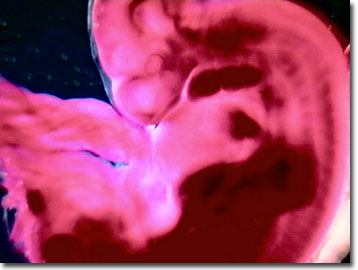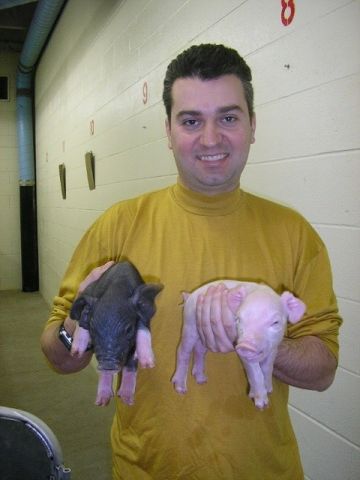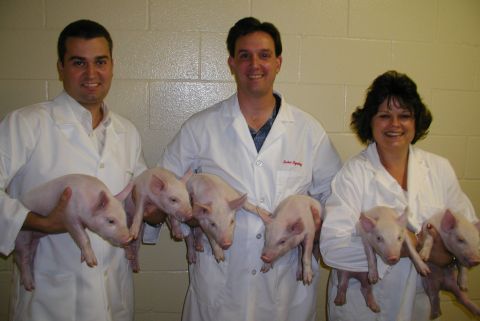- GnRH Receptor Gene
- GnRHR-II
- Embryonic Development
- Transgenic Animal Production
- A Gene Is Just A Gene
- From Molecular Biology to Swine Reproduction
GnRH Receptor Gene

Our laboratory is not only interested in the basal expression of the porcine GnRHR gene, but also the role of this gene in determination of ovulation rate. Towards this end, we utilized genomic sequences from strains of swine divergent for ovulation rate. The index line of swine developed at UNL by Dr. Rodger Johnson has undergone selection based on an index of ovulation rate and embryonic survival. This results in approximately 7 more oocytes per ovulation and 1 to 2 more piglets per litter than the control white cross line examined in the previous experiments. Chinese Meishan females have approximately 4 to 5 more piglets per litter, partially attributed to increased ovulation rates. In 2001, Jiang and co-workers identified nucleotide differences between the genomic sequences of Chinese Meishan and occidental strains of pigs.
Our graduate students work on the research projects for hands-on experience, here are four of our outstanding students with their posters on the GnRH Receptor Genes:
Rebecca Cederberg: B.S. Biology, University of Nebraska-Lincoln
- Transcriptional Regulation of the porcine GnRH Receptor (GnRHR) Gene PDF(106 kb)
- Cell specific expression of the Porcine GnRH Receptor(GnRH) gene is conferred by multiple elements, including a SF-1 binding Site, located within 1900bp of 5' flanking region. (July 2003 SSR) PDF (148 kb)
- Activity of the Porcine GnRH Receptor gene promoter in Alphe T3-1 cells is partially conferred by a Steroidogenic factor -1 binding site and a complex enhancer located at -1716/-1666 of proximal promoter (July 2006 SSR) PDF (142 kb)
Emily McDonald: B.S., Animal Science, Cal Poly, San Luis Obispo, 2003, M.S., University of Nebraska, 2005
- Differential Regulation of the porcine Gonadotropin-Releasing Hormone Receptor (GnRHR) Gene between lines of swine divergent for ovulation rate is conferred by elements within 1400 bp of 5' flanking region (PDF 35 kb)
- Divergent activity of GnRH receptor (GnRH) gene promoters amoung lines of swine is partially conferred by an NF-kB Element Society for the Study of Reproduction (SSR) in Quebec City - Presented July 2005 PDF (68 kb)
Chanho Lee: B.S., Konkuk University in Korea, 1996; M.S., Konkuk University in Korea, 1998, Ph.D. University of Nebraska 2015
Jacqueline Smith: B.S. Animal Science, University of Connecticut, M.S. Animal Science, University of Nebraska, May 2008
GnRHR-II
Our graduate students work on the research projects for hands-on experience, here are two of our outstanding students with their posters on the GnRH-II Receptor Genes:Jocelyn Wairda:
Vanessa Brauer: B.S. Cal Poly - San Luis Obispo - 2006, M.S. Animal Science - Physiology - UNL 2009
Embryonic Development

GnRH may have an important role in early embryonic development. The interaction between GnRH and its receptor in gonadotropes of the anterior pituitary gland represents a key point for regulation of the reproductive process. Besides its established action, there is evidence that extra-pituitary GnRH acts via autocrine/paracrine mechanisms in multiple tissues. Protein for GnRH and mRNA for both GnRH and its receptor have been detected in human uterine endometrium and oviduct as well as in embryos at the morula/ blastocyst stage in the mouse and human.Our laboratory has examined the effect of a GnRH agonist and antagonist on the development of mouse embryos in vitro. We suggest that GnRH has an important autocrine effect on early embryonic development, potentially signaling via PKC. Additionally, we investigated the functional importance of GnRH on development of pre-implantation mouse embryos in vitro. Results indicated that GnRH-I or its agonists were unable to rescue inhibition of blastocyst development by SB-75. Based on these data, we suggest that GnRH-I has an essential autocrine effect on embryonic development and additional GnRH is not stimulatory. Thus, more studies are necessary to understand the relationship between GnRH and the embryo during early development.

Pig Embryo
As one of the first dissection animals
experienced in comparative anatomy laboratory, fetal or embryonic pigs are very well studied because their development and organ systems reasonably parallel human development. Pig embryos are also playing a role in reproductive biology whether used in embryo transfers for advanced livestock breeding and production, or for studying techniques for improving human fertility and birthing success.
Although domestic pigs (Sus scrofa) are not closely related to humans, it has been long known by swine producers, veterinarians, and physicians that similarities must exist between the immune systems of both mammalian species since each can act as a disease vector for the other. In fact, one of the largest pandemic disease outbreaks to ever hit the human race, the flu epidemic of 1918, was most likely a swine flu transferred from the barnyard animals to humans, probably by respiratory fluids. If humans visit modern, relatively aseptic corporate swine production facilities, they must first shower and don sanitized shoes and clothing and not enter if they have a cold or virus, in order to not infect the hogs.
Pigs are notoriously omnivorous and eat a large variety of plants, animals, and carrion. Given a bad rap because they like to wallow in mud to cool off and moisturize their skin, pigs tend to be much cleaner than most animals. Feral pigs root and dig in the ground, feeding on roots, and in some areas of the world, cause ecological damage by destroying rare habitats and eating endangered flora and fauna. Feral pigs were accidentally introduced throughout the world by fifteenth century explorers that carried live hogs aboard ships as an easily maintained (they eat garbage and scraps), renewable protein source for the crew. With a lifespan of 9 to 15 years and reaching maturity as early as 8 months of age, an adult sow can weigh up to 450 pounds, giving birth to an average of 8 to 12 piglets (but as many as 30). The gestation period for pigs is about 114 days, or a little more than half as long as that of humans.
In terms of intelligence, pigs are probably the most intelligent of the domesticated animals, perhaps smarter than even most dogs. In the order Artiodactyla, pigs are considered even-toed ungulates and are placed in the family Suidae. Under domestication, many breeds of the S. scrofa have been developed and have fallen in and out of production favor based on the meat and leather market demands. Promoted as the "other white meat", pork, if not cooked properly, can transmit trichinosis to humans via the parasitic nematode Trichinella spiralis.
Molecular Expressions™ Science, Optics & You, Mic-D Digital Microscope
Darkfield Digital Image Gallery
Contributing Authors Cynthia D. Kelly, Thomas J. Fellers and Michael W. Davidson - National High Magnetic Field Laboratory, 1800 East Paul Dirac Dr., The Florida State University, Tallahassee, Florida, 32310.

Swine Embryo Freezing
Successful freezing, or cryopreservation of embryos could greatly impact the swine industry, serving as a tool for conservation of valuable germplasm and enhancing biosecurity for transfer of genetic material. Pig embryos are very sensitive to cooling and few reports have shown successful developmental rates following freezing. The objective of our research is to determine the cellular mechanisms associated with the enhanced ability of embryos from Chinese Meishan females to survive the freezing process compared to embryos from occidental lines of swine. This may lead to improved freezing protocols for pig embryos, as well as embryos from other species.
Photo: Marcelo Montagner showing off embryo transfer success...Chinese Meishan and white crossbred piglets born at the University of Nebraska.
To view Marcelo's publication entitled: Freezing swine embryo's: Do success rates differ between breeds. View in
Nebraska Swine Report
Recovery of porcine embryo's surgery PDF (1.51 mb)
Freezing Swine Embryo's

Do Success rates differ between Breeds?
Former White Lab graduate student Dr. Marcelo Montagner, Dr. Brett White (Reproductive Biology Lab Director) and Ginger Mills show off frozen embryo piglets.
The objectives of this study were to determine the efficiency of freezing pig embryo's using a micodroplet vitrification method and to investigate in vitro development of embryos from Chinese Meishan and occidental white crossbred females following cryopreservation at different stages of embryonic development.
This research was published in the Nebraska Swine Report
Our graduate students help with all of our research here are some of the outstanding work they have accomplished:Amy Cropp: B.S., Animal Science, University of Nebraska, 2004, M.S., University of Arizona, 2006
Marcelo Montagner: DVM, M.S., Santa Maria Federal University, Brazil, 1999, Ph.D., Santa Maria Federal University, Brazil and Visiting Scholar, University of Nebraska, 2005
- Freezing Swine Embryos: Do Success Rates Differ Between Breeds?Published in Nebraska Swine Report
Jennafer Glaesemann:
Georgia, Times New Roman, Times, serif B.S. Animal Science and Veterinary Science (Pre-Vet) UNL, 2007
Transgenic Animal Production

The nucleus of all cells in every living organism contains genes made up of DNA. These genes store information that regulates how our bodies form and function. Genes can be altered artificially, so that some characteristics of an animal are changed. For example, an embryo can have an extra, functioning gene from another source artificially introduced into it, or a gene introduced which can knock out the functioning of another particular gene in the embryo. Animals that have their DNA manipulated in this way are knows as transgenic animals.
Ashlee Poulas: B.S. UNL-Animal Science
Georgia, Times New Roman, Times, serif B.S. Animal Science and Veterinary Science (Pre-Vet) UNL, 2007
- Production of Transgenic Mice to Evaluate Activin Responsiveness of the Porcine GnRH Receptor Gene
A Gene Is Just A Gene
A Gene is Just a Gene PDF (174 kb)
From Molecular Biology to Swine Reproduction
Return to Main Page